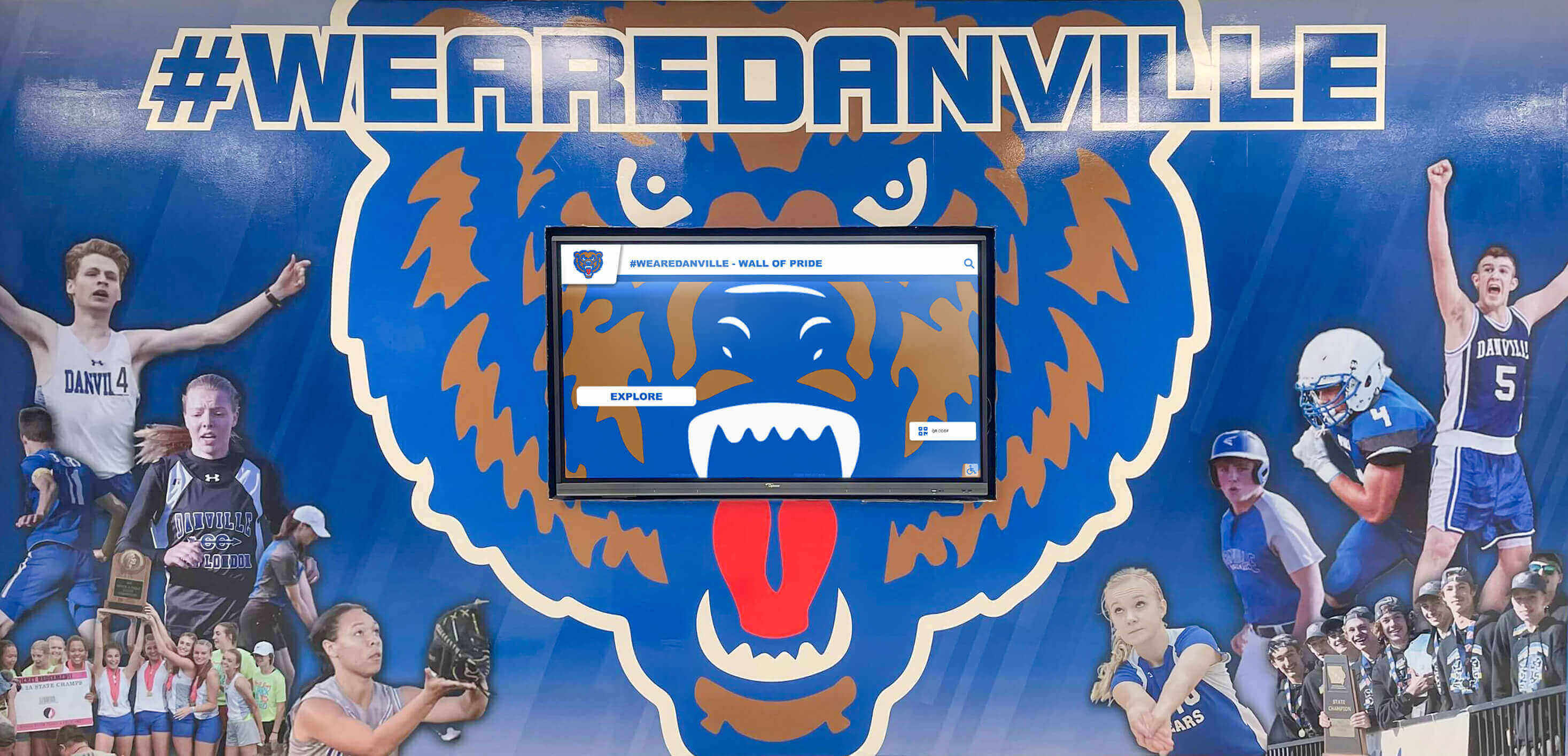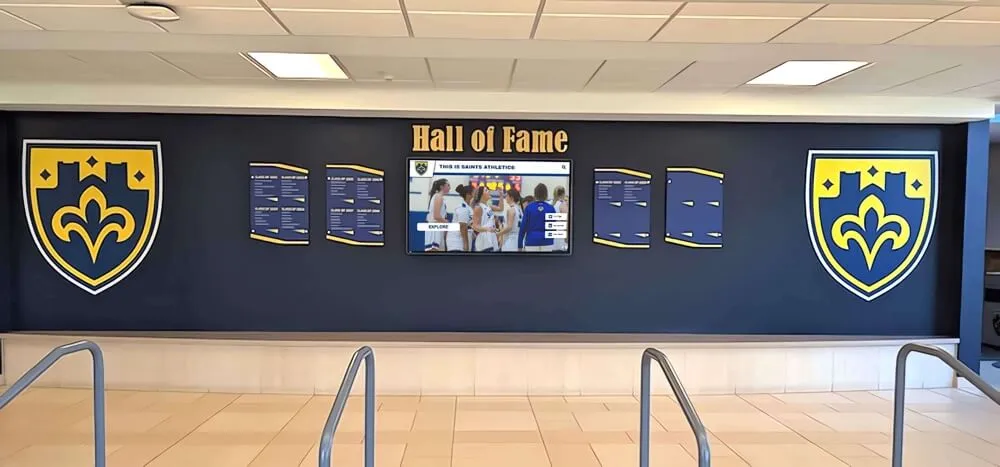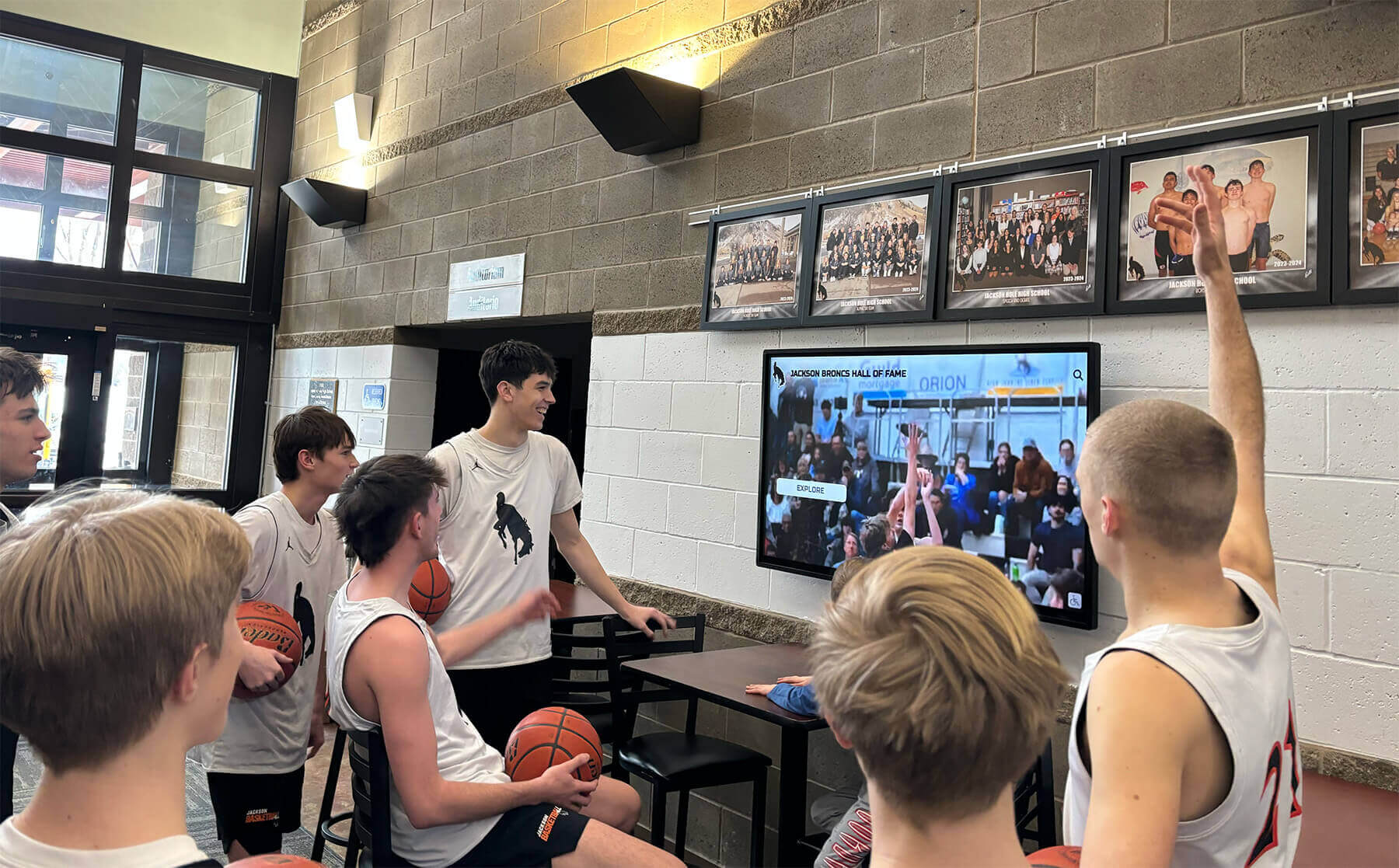Key Takeaways
Comprehensive guide to basketball halls of fame, from the Naismith Memorial Basketball Hall of Fame in Springfield to creating your own school or organizational basketball recognition program with modern digital displays.
The Naismith Memorial Basketball Hall of Fame: Basketball’s Ultimate Honor
Located in Springfield, Massachusetts—the birthplace of basketball where Dr. James Naismith invented the game in 1891—the Naismith Memorial Basketball Hall of Fame stands as basketball’s most prestigious recognition institution, honoring individuals and teams whose extraordinary contributions shaped the sport’s evolution across more than a century.
History and Significance
The Basketball Hall of Fame was established in 1959 and inducted its first class in 1960, creating a permanent home for basketball’s greatest legends. The current museum facility, which opened in 2002, features more than 40,000 square feet of basketball history, houses over 475 inductees, and welcomes nearly 200,000 visitors annually who come to celebrate the sport’s heritage and honor its most distinguished contributors.
Beyond serving as a museum and shrine to basketball excellence, the Hall of Fame operates over 70 high school and collegiate basketball competitions annually throughout the United States and internationally, promoting the game at grassroots levels while identifying future stars who may one day join the honored ranks of inductees.

The Enshrinement Process and Selection Criteria
The Naismith Hall of Fame’s rigorous selection process ensures that only those who achieved exceptional distinction in basketball earn enshrinement:
Eligibility Requirements:
Players must be fully retired from professional basketball for four full seasons before becoming eligible for consideration, ensuring sufficient time for evaluating complete careers and lasting impact. This waiting period was recently shortened from five years to better recognize distinguished careers in a more timely manner while maintaining perspective on achievements.
Coaches must work in their profession for at least 25 years before eligibility, though they need not be retired. This longevity requirement recognizes that coaching excellence emerges over extended periods of sustained success, mentorship, and program building.
Contributors—including executives, administrators, team owners, and others who significantly advanced basketball—are eligible at any time based on their substantial contributions to the sport’s growth, development, or administration.
The Selection Committees:
The election process involves multiple specialized screening committees that review candidates and determine finalists:
- North American Screening Committee: Evaluates players, coaches, and contributors from North American professional, collegiate, and amateur basketball
- Women’s Screening Committee: Focuses on female players, coaches, and contributors
- Direct-Elect Committees: Include the Early African-American Pioneers Committee, International Committee, Veterans Committee (for those retired 35+ years), and Contributors Committee
Each screening committee narrows nominee pools to finalists through anonymous voting processes requiring substantial committee support. The North American committee, for example, consists of nine members who meet annually to review 40-50 nominees, narrowing the field to no more than ten finalists, each requiring support from a minimum of seven committee members.
Honors Committee Voting:
Twenty-four voting members serve on each of the two Honors Committees (North American and Women’s), comprising Hall of Famers, basketball executives and administrators, media members, and game experts. Finalists must receive at least 18 votes (75%) from the respective Honors Committee to earn enshrinement.
This multi-committee structure with substantial vote requirements ensures thorough evaluation, prevents single-perspective bias, and maintains enshrinement standards befitting basketball’s highest honor.
Class of 2025 Inductees
The Basketball Hall of Fame announced its Class of 2025 in April, selecting nine inductees who will be enshrined during ceremonies in September:
Players:
- Carmelo Anthony: Ten-time NBA All-Star, NCAA champion at Syracuse, three-time Olympic gold medalist, and one of the most prolific scorers in basketball history
- Dwight Howard: Eight-time NBA All-Star, three-time NBA Defensive Player of the Year, five-time All-NBA First Team selection, and dominant force who revolutionized the center position
- Sue Bird: Four-time WNBA champion, 13-time WNBA All-Star, five-time Olympic gold medalist, and architect of the Seattle Storm’s dynasty
- Maya Moore: Four-time WNBA champion, two-time Olympic gold medalist, WNBA MVP, and advocate whose social justice work transcended basketball
- Sylvia Fowles: Four-time WNBA Defensive Player of the Year, two-time WNBA champion, WNBA MVP, and one of the most dominant post players in women’s basketball history
Other Categories:
- Billy Donovan: Two-time NCAA national champion coach at Florida, successful NBA coach, and mentor who developed numerous professional players
- Danny Crawford: Longtime NBA referee who officiated over 2,300 regular season games and 50 playoff series with distinction and professionalism
- Micky Arison: Miami Heat managing general partner whose leadership built one of the NBA’s most successful franchises
- 2008 U.S. Olympic Men’s Basketball Team: The “Redeem Team” that reclaimed Olympic gold in Beijing with dominant performances
Creating Basketball Halls of Fame for Schools and Organizations
While the Naismith Hall of Fame represents basketball’s pinnacle honor, thousands of high schools, colleges, recreation departments, and basketball organizations operate successful hall of fame programs recognizing local and regional excellence that inspired communities and established basketball traditions at grassroots levels.
Why Schools Need Basketball Hall of Fame Programs
Basketball hall of fame recognition delivers significant benefits for educational and community basketball programs:
Preserving Program History:
Athletic achievements represent important institutional history worth documenting systematically. As decades pass, legendary players graduate, coaches retire, and memories fade—but hall of fame programs create permanent records ensuring outstanding achievements remain part of collective consciousness rather than being gradually forgotten. Creating comprehensive halls of fame preserves these institutional legacies for future generations.
Inspiring Current Athletes:
When young basketball players see tangible evidence that athletes who once wore the same uniform achieved remarkable success, their own aspirations expand. Recognition displays answer the critical question every athlete asks: “What’s possible for someone like me?” Visible achievement standards create concrete goals that transform abstract aspirations into specific, measurable objectives athletes pursue through intentional training and competitive focus. Research on the psychology of athletic recognition demonstrates how visible achievements significantly impact motivation and performance.
Strengthening Alumni Engagement:
Former athletes who feel valued through hall of fame recognition maintain stronger connections to programs throughout their lives. Recognition creates natural touchpoints for re-engagement—induction ceremonies bring alumni back, recognition announcements create communication opportunities, and displays themselves spark conversations during campus visits. These connections often translate into increased support, volunteerism, and philanthropic giving. Exploring best ways to connect with alumni provides additional strategies for maintaining these valuable relationships.
Building Program Pride and Identity:
Hall of fame programs contribute significantly to athletic program culture and community identity. They create visible traditions that distinguish programs, generate positive stories for media coverage and recruitment, provide content that celebrates achievement, and strengthen collective pride among stakeholders. Over time, these programs become integral to institutional identity.

Establishing Selection Criteria and Processes
Credible basketball hall of fame programs require transparent selection criteria ensuring fair, defensible decisions that maintain recognition standards:
Player Recognition Categories:
Comprehensive programs recognize diverse basketball achievements:
- Statistical Excellence: Career scoring leaders, all-time assist leaders, rebounding champions, and athletes who set program records demonstrating sustained performance
- All-Conference and All-State Honors: Players earning conference or state recognition whose excellence achieved recognition beyond institutional boundaries
- Championship Contributors: Members of conference championship, state tournament, or national championship teams whose collective achievements merit recognition
- 1,000-Point Club: High school players reaching the prestigious 1,000-career-point milestone representing years of scoring excellence
- Character and Leadership: Team captains, sportsmanship award winners, and athletes who embodied program values while achieving athletic success
Programs using digital displays for 1,000-point scorer recognition can celebrate these milestone achievements with rich profiles that inspire underclassmen pursuing similar excellence.
Coaching Recognition:
Outstanding coaches who built programs, developed talent, and created winning traditions deserve recognition alongside players:
- Conference and state championships won
- Career victory milestones (100, 200, 500+ wins)
- Years of service to single programs
- Players developed who earned college scholarships
- Coaching awards and honors received
- Professional development and mentorship of assistant coaches
Eligibility Standards:
Establish clear requirements preventing confusion:
- Minimum waiting periods (typically 5-10 years for players, ensuring perspective on careers)
- Completion of high school or college eligibility at the institution
- Character and conduct standards ensuring recognized individuals represent program values appropriately
- Achievement thresholds establishing meaningful recognition standards
Nomination and Selection:
Structured processes maintain program credibility:
- Annual nomination periods with clear deadlines
- Standardized nomination forms requesting comprehensive information
- Selection committees with diverse membership (administrators, coaches, alumni, community members)
- Transparent voting procedures requiring substantial committee support
- Documentation of decision rationales for institutional memory
Resources on establishing high school halls of fame from the National Federation of State High School Associations provide additional frameworks for developing credible recognition programs.
Modern Display Options: Traditional vs. Digital Recognition
Schools and organizations implementing basketball hall of fame programs face important decisions about display formats, each offering distinct advantages:
Traditional Physical Displays
Engraved Plaques and Nameplates:
Classic brass or bronze plaques mounted on dedicated walls provide permanent, formal recognition creating impressive visual impact, particularly when arranged in organized patterns that grow over time. Traditional plaques work well for institutions valuing permanence and classic aesthetics.
Limitations:
- Space constraints eventually limit expansion
- Updates or corrections require expensive plaque replacement
- Limited information capacity (typically just name, year, achievement)
- Physical deterioration from exposure and aging
- Ongoing costs for materials and installation
Photo Display Boards:
Framed photographs with biographical text offer more personal connection than simple nameplates. Visitors relate more strongly when seeing inductees’ faces alongside achievement narratives.
Limitations:
- Maintaining consistent photography quality and styling proves challenging across decades
- Similar space limitations as plaque installations
- Difficult to update or correct information
- Physical maintenance requirements (glass cleaning, frame repair, protection from sunlight)

Digital Interactive Recognition Systems
Modern digital recognition platforms overcome traditional limitations while creating enhanced engagement experiences that transform how schools celebrate basketball excellence:
Unlimited Recognition Capacity:
Digital systems accommodate unlimited inductees without physical space constraints. Whether recognizing 50 athletes or 500, the footprint remains constant. Schools can honor every deserving athlete from program history—1,000-point scorers from the 1960s receive equal prominence with last season’s all-state selections.
Instant Content Updates:
When a player breaks a scoring record during Friday night’s game, displays can be updated by Saturday morning. Cloud-based content management systems allow updates from any internet-connected device in minutes rather than the weeks required for physical plaque ordering, fabrication, and installation.
Rich Multimedia Content:
Digital platforms enable comprehensive athlete profiles including:
- Professional photographs and action shots from memorable games
- Career statistics and season-by-season progression charts
- Video highlights of championship performances and record-breaking games
- Written profiles celebrating achievements and personal journeys
- Post-graduation accomplishments and current status
- Audio interviews with athletes reflecting on their experiences
Interactive Exploration:
Touchscreen interfaces invite active engagement through:
- Search functions finding specific athletes or teams by name
- Filtering by graduation year, achievement type, or category
- Photo galleries browsing through program history visually
- Video playback of championship moments and highlight performances
- Detailed statistical breakdowns and historical comparisons
Remote Accessibility:
Web-based viewing extends recognition beyond physical displays, allowing athletes to share achievements with family through social media while alumni can access program information from anywhere. This expanded reach amplifies recognition impact while strengthening connections with geographically dispersed stakeholders.
Lower Long-Term Costs:
While digital systems require higher initial investment ($5,000-$15,000 for comprehensive installations), they eliminate ongoing per-update costs that accumulate with traditional systems. Most schools achieve cost neutrality within 3-5 years while gaining dramatically superior capabilities. Understanding comprehensive digital hall of fame benefits helps schools evaluate the complete value proposition.
Solutions like Rocket Alumni Solutions provide purpose-built platforms designed specifically for school athletic recognition rather than generic digital signage systems requiring extensive customization. These specialized systems deliver intuitive content management, professional templates, and ongoing support ensuring schools can maintain impressive displays without requiring technical expertise.
State and Regional Basketball Halls of Fame
Beyond the Naismith Memorial Basketball Hall of Fame and individual school programs, numerous state and regional basketball halls of fame celebrate the sport’s impact in specific geographic areas:
Kentucky High School Basketball Hall of Fame
Established in 2012, the Kentucky High School Basketball Hall of Fame recognizes and promotes the tradition and rich heritage of Kentucky high school basketball. The program honors outstanding players, coaches, and contributors who shaped one of America’s most passionate basketball cultures.
Kentucky’s basketball tradition—immortalized in books and films celebrating small-town programs competing for state championships—creates particularly strong demand for hall of fame recognition that preserves stories of legendary teams, rivalries, and athletes who captured imaginations across the state.
Indiana Basketball Hall of Fame
Indiana’s basketball heritage rivals any state in the nation, celebrated through the Indiana Basketball Hall of Fame, a facility featuring roughly 21,000 square feet of exhibits preserving Indiana’s game for future generations. A 6,600 square foot expansion opened in December 2024, reflecting the state’s continued commitment to basketball history preservation.
Indiana’s basketball culture—from “Hoosier Hysteria” to legendary high school gyms to college and professional success—provides abundant material for comprehensive hall of fame recognition documenting the sport’s central role in state identity.
Ohio Basketball Hall of Fame
Founded in 2005, the Ohio Basketball Hall of Fame recognizes remarkable achievements of male and female athletes across high school, college, and professional basketball. The organization preserves Ohio’s significant basketball contributions, including numerous NBA players, WNBA stars, successful college coaches, and influential administrators who emerged from Ohio programs.
These state and regional halls of fame demonstrate that basketball recognition programs succeed at multiple levels, from national institutions honoring global legends to state organizations celebrating regional excellence to individual schools recognizing local achievements.

Implementing Your Basketball Hall of Fame Program
Successfully launching a basketball recognition program requires systematic planning addressing multiple implementation dimensions:
Phase 1: Planning and Foundation (Months 1-3)
Define Program Objectives:
Clarify primary purposes—preserving history, inspiring current athletes, engaging alumni, enhancing recruiting, or building program pride. Clear objectives guide subsequent decisions about criteria, formats, and resource allocation.
Establish Selection Criteria:
Document specific eligibility requirements, achievement thresholds, character standards, and recognition categories. Transparent criteria prevent confusion while establishing consistent frameworks for fair evaluation.
Form Selection Committee:
Assemble diverse committees including athletic administrators, coaches, alumni representatives, and community members. Staggered multi-year terms ensure continuity while regularly refreshing perspectives.
Develop Budget:
Create realistic financial projections including initial investment (displays, content creation, installation) and ongoing operational costs (annual additions, maintenance, software subscriptions). Identify funding sources from athletic budgets, booster organizations, alumni donations, or dedicated fundraising campaigns.
Phase 2: Content Development (Months 3-6)
Select Inaugural Inductees:
Begin with manageable inaugural classes ensuring diverse representation across:
- Achievement categories (scoring, defense, playmaking, leadership)
- Graduation eras spanning program history
- Gender representation for co-ed programs
- Various positions and playing styles
Gather Information and Assets:
Systematically collect content through:
- Direct outreach to living alumni with questionnaires
- Archival research in yearbooks, newspapers, and program records
- Interviews with coaches, teammates, and family members
- Photo collection from institutional archives and personal collections
- Statistical verification from official records
Create Professional Profiles:
Develop comprehensive biographical narratives including:
- Career statistics and season-by-season progression
- Notable performances and memorable games
- Team achievements during their playing years
- Individual honors and recognition received
- Post-basketball accomplishments and current status
- Personal reflections on their basketball experience
Effective digital athletic recognition programs showcase athletes comprehensively, celebrating both statistical achievement and character dimensions that inspire current students. Schools can also explore interactive timeline displays that contextualize individual achievements within broader program history.
Phase 3: Display Implementation (Months 6-9)
Select Display Format:
Choose between traditional physical displays, digital interactive systems, or hybrid approaches based on:
- Budget availability and long-term cost considerations
- Space constraints and expansion plans
- Desired content depth and multimedia capabilities
- Technical resources for system management
- Stakeholder preferences and institutional culture
Design and Installation:
Work with specialized providers or contractors to:
- Design displays reflecting institutional branding and aesthetic
- Select appropriate display sizes for viewing distances
- Choose strategic placement in high-visibility locations
- Ensure proper mounting, connectivity, and accessibility
- Test thoroughly before public unveiling
Content Loading:
Import inductee profiles, organize navigation structures, configure search and filtering options, verify all information displays correctly, and train staff on content management and system operation.
Phase 4: Launch and Ongoing Operations (Month 9+)
Induction Ceremony:
Create memorable inaugural events celebrating initial inductees with formal programs, speeches from institutional leaders, display unveilings, receptions allowing attendee interaction, and media coverage amplifying reach.
Annual Cycles:
Establish predictable rhythms for:
- Fall nomination periods with community outreach
- Winter selection committee deliberations
- Spring inductee announcements and profile development
- Summer preparation and content updates
- Fall induction ceremonies during homecoming or major events
Content Enhancement:
Maintain engagement through profile enhancements, featured inductee rotations, achievement updates as alumni reach new milestones, and multimedia additions enriching existing content.
Digital hall of fame maintenance strategies help schools manage systems effectively while ensuring reliable operation and professional appearance over years of continuous use. Additionally, schools should consider best practices for digital asset management to organize and preserve historical photos and videos.

Integrating Basketball Recognition with Comprehensive Athletic Programs
The most effective recognition systems integrate basketball halls of fame within broader athletic recognition programs celebrating excellence across all sports:
Multi-Sport Digital Recognition
Comprehensive athletic displays accommodate:
- Basketball halls of fame featuring players, coaches, and teams
- Football records and recognition honoring gridiron achievements
- Championship team celebrations across all sports
- All-state athlete recognition regardless of sport
- Academic athlete honors celebrating classroom excellence
- Leadership and character awards recognizing values
Digital systems excel at multi-sport recognition because unlimited capacity prevents competition for limited space. Every sport receives appropriate recognition without compromising other programs—basketball hall of famers receive comprehensive profiles alongside football legends, volleyball record holders, track and field achievements, and distinguished athletes from every program.
Athletic Wall of Honor Displays
Broader athletic walls of honor complement sport-specific halls of fame by recognizing:
- Conference championships across all sports
- State tournament and playoff appearances
- Team academic achievements and scholar-athlete honors
- Coaching milestones and awards
- Athletic department award winners
- Community service and leadership recognition
This comprehensive approach ensures all athletic achievement receives appropriate visibility while maintaining sport-specific recognition for detailed profiles celebrating individual excellence within each program.
Integrating Academic Recognition
The most holistic programs connect athletic and academic achievement:
- Highlighting athlete grade point averages alongside statistics
- Featuring Academic All-Conference and All-State honors
- Recognizing post-graduation educational achievements
- Celebrating scholar-athlete award winners
- Profiling career success in fields beyond sports
This integrated recognition communicates institutional values emphasizing comprehensive excellence—athletic achievement paired with academic success and strong character—rather than celebrating athletics in isolation from broader educational missions. Programs can learn from strategies for recognizing valedictorians that balance academic and extracurricular achievements.
Measuring Basketball Hall of Fame Program Success
Effective recognition programs demonstrate value through both quantitative metrics and qualitative observations:
Quantitative Indicators
Usage Metrics for Digital Systems:
- Number of interactions with displays
- Time spent exploring content
- Most-viewed athlete profiles
- Peak engagement times and patterns
- Web traffic to online hall of fame platforms
Performance Indicators:
- Athletic participation rates in basketball programs
- Number of athletes reaching recognition milestones
- Alumni engagement and giving rates
- Prospective student interest during recruitment visits
Cost Savings:
- Eliminated traditional board update expenses
- Reduced staff time managing recognition
- Avoided replacement costs for deteriorating physical displays
Qualitative Assessment
Athlete Perspectives:
Regular feedback from student-athletes provides crucial insights about how meaningful they find recognition, whether displays influence their goal-setting, how recognition affects program pride, and ideas for improving recognition experiences.
Coach Observations:
Coaches notice cultural shifts including whether athletes reference hall of fame members in conversations, whether players set specific achievement goals, and whether underclassmen engage with program traditions and history.
Alumni and Community Feedback:
Broader stakeholder perspectives from alumni reactions during campus visits, family comments at recognition events, community awareness of program achievements, and media coverage of hall of fame activities provide valuable external validation.
The most important impacts often involve qualitative cultural shifts—current athletes feeling connected to program history, school community perception of athletics improving, athletes demonstrating pride in representing traditions, and historical achievements inspiring current teams during challenging seasons.

Conclusion: Honoring Basketball Excellence Across All Levels
Basketball halls of fame serve vital purposes whether honoring legends at the national level through the Naismith Memorial Basketball Hall of Fame in Springfield or celebrating local heroes through school and community recognition programs. From Carmelo Anthony’s professional excellence to the high school player who led a small-town team to an unlikely championship, basketball achievement at every level deserves appropriate recognition that preserves legacies while inspiring future generations.
The Naismith Hall of Fame’s rigorous selection process, comprehensive exhibits, and prestigious enshrinement ceremonies establish standards for basketball recognition worldwide. The Class of 2025—featuring luminaries like Sue Bird, Dwight Howard, and Maya Moore—demonstrates the diverse pathways to basketball distinction encompassing professional excellence, Olympic achievement, coaching success, and contributions to the sport’s growth.
For schools and organizations creating their own basketball recognition programs, modern digital solutions overcome the limitations of traditional physical displays while delivering superior long-term value. Unlimited capacity ensures every deserving athlete receives recognition, instant updates enable timely celebration of current achievements, rich multimedia content creates emotional connections impossible with simple plaques, and interactive features engage visitors in exploration of program history.
Whether implementing comprehensive athletic recognition across all sports or focusing specifically on basketball achievements, purpose-built solutions like those from Rocket Alumni Solutions provide intuitive platforms that schools can manage confidently without technical expertise. These systems transform recognition from static name lists into engaging experiences that honor past excellence while inspiring current athletes to pursue their own places in program history.
Basketball’s impact extends far beyond statistics and championships—the sport teaches teamwork, perseverance, leadership, and character while creating memories and relationships lasting lifetimes. Effective hall of fame programs ensure these profound contributions receive the lasting recognition they deserve, connecting past legends with present competitors and future stars in continuous traditions of basketball excellence.
Visit Rocket Alumni Solutions to explore how modern recognition technology transforms basketball achievement celebration from space-constrained physical displays into comprehensive digital experiences that honor program traditions while engaging contemporary audiences through intuitive, professional platforms designed specifically for school and organizational athletic recognition.





































